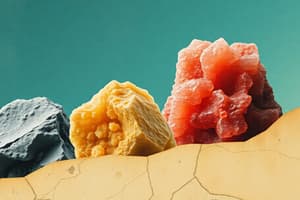Podcast
Questions and Answers
Oxygen and Silicon are the two most abundant elements in the Earth's crust.
Oxygen and Silicon are the two most abundant elements in the Earth's crust.
True (A)
Silicon is primarily bonded to Nitrogen in common minerals.
Silicon is primarily bonded to Nitrogen in common minerals.
False (B)
The eight major elements in the Earth's crust include Helium and Carbon.
The eight major elements in the Earth's crust include Helium and Carbon.
False (B)
Silica is the primary constituent of common minerals like quartz and feldspar.
Silica is the primary constituent of common minerals like quartz and feldspar.
Understanding the major elements in common minerals is not important for appreciating their unique properties.
Understanding the major elements in common minerals is not important for appreciating their unique properties.
The presence of silica in minerals has no influence on their characteristics.
The presence of silica in minerals has no influence on their characteristics.
Iron is an essential element in minerals like magnetite, hematite, and ilmenite.
Iron is an essential element in minerals like magnetite, hematite, and ilmenite.
Copper is present in minerals like halite and potash.
Copper is present in minerals like halite and potash.
Sodium and potassium are essential elements in minerals like feldspar and mica.
Sodium and potassium are essential elements in minerals like feldspar and mica.
Calcium is a primary component in minerals like calcite, dolomite, and gypsum.
Calcium is a primary component in minerals like calcite, dolomite, and gypsum.
Magnesium is not an essential element in any common minerals.
Magnesium is not an essential element in any common minerals.
Beryllium and titanium are constituents of minerals like beryl and rutile.
Beryllium and titanium are constituents of minerals like beryl and rutile.
Study Notes
Common Minerals and Their Building Blocks: Elements
Minerals are the basic building blocks of the Earth's crust, playing a fundamental role in shaping our planet's landscapes and sustaining life as we know it. Each mineral is composed of one or more types of elements, and understanding these elements is key to grasping the diverse and fascinating world of minerals.
The Elements Found in Common Minerals
More than 98% of the Earth's crust is made up of eight elements, collectively known as the major elements. These elements, in decreasing order of abundance, are:
- Oxygen (O)
- Silicon (Si)
- Aluminum (Al)
- Iron (Fe)
- Calcium (Ca)
- Sodium (Na)
- Potassium (K)
- Magnesium (Mg)
These eight elements are present in almost all common minerals, and understanding their roles within these minerals is essential to appreciating their unique properties.
Oxygen (O) and Silicon (Si): The Foundation of Minerals
Oxygen and silicon are the most abundant elements in the Earth's crust and are the foundation of most common minerals. Silicon is often bonded to oxygen to form silicon dioxide (SiO2), or silica, which is the primary constituent of many common minerals such as quartz, feldspar, and mica.
Silica is the most abundant compound on Earth's surface, and its structural flexibility enables minerals to exhibit a wide range of characteristics. The presence of silica in minerals also influences their hardness, color, and transparency.
Other Major Elements in Common Minerals
Besides silicon and oxygen, other major elements found in common minerals include:
-
Aluminum (Al): Aluminum forms strong covalent bonds with oxygen, silicon, and other elements, making it an essential component in minerals like feldspar, mica, and clay.
-
Iron (Fe): Iron is an essential element in many common minerals, such as magnetite, hematite, and ilmenite. It contributes to the mineral's color, hardness, and magnetic properties.
-
Calcium (Ca): Calcium is one of the most abundant elements in the Earth's crust, and it is a primary component in minerals like calcite, dolomite, and gypsum.
-
Sodium (Na) and Potassium (K): Sodium and potassium, along with their ionic forms (Na+ and K+), are essential elements in minerals like halite (sodium chloride) and potash (potassium chloride).
-
Magnesium (Mg): Magnesium is an essential element in minerals like periclase, brucite, and dolomite.
Minor Elements in Minerals
While the major elements account for the bulk of a mineral's composition, there are also numerous minor and trace elements that contribute to the unique characteristics of minerals. Some examples include:
- Copper (Cu): Copper is present in minerals like azurite, malachite, and chalcopyrite.
- Aluminum (Al) and Iron (Fe): Aluminum and iron form the basis of minerals like alum, corundum, and hematite.
- Beryllium (Be) and Titanium (Ti): Beryllium and titanium are constituents of minerals like beryl and rutile.
Understanding the elements that make up common minerals provides insight into the properties of these minerals and their role in shaping our planet. The next time you encounter a mineral, remember that its unique properties may be attributed to the specific combination and arrangement of elements that make it up.
Studying That Suits You
Use AI to generate personalized quizzes and flashcards to suit your learning preferences.
Description
Test your knowledge of the elements that make up common minerals, from oxygen and silicon as foundational components to aluminum, iron, calcium, sodium, potassium, and magnesium. Learn about how these elements contribute to the unique properties of minerals and their abundance in the Earth's crust.




